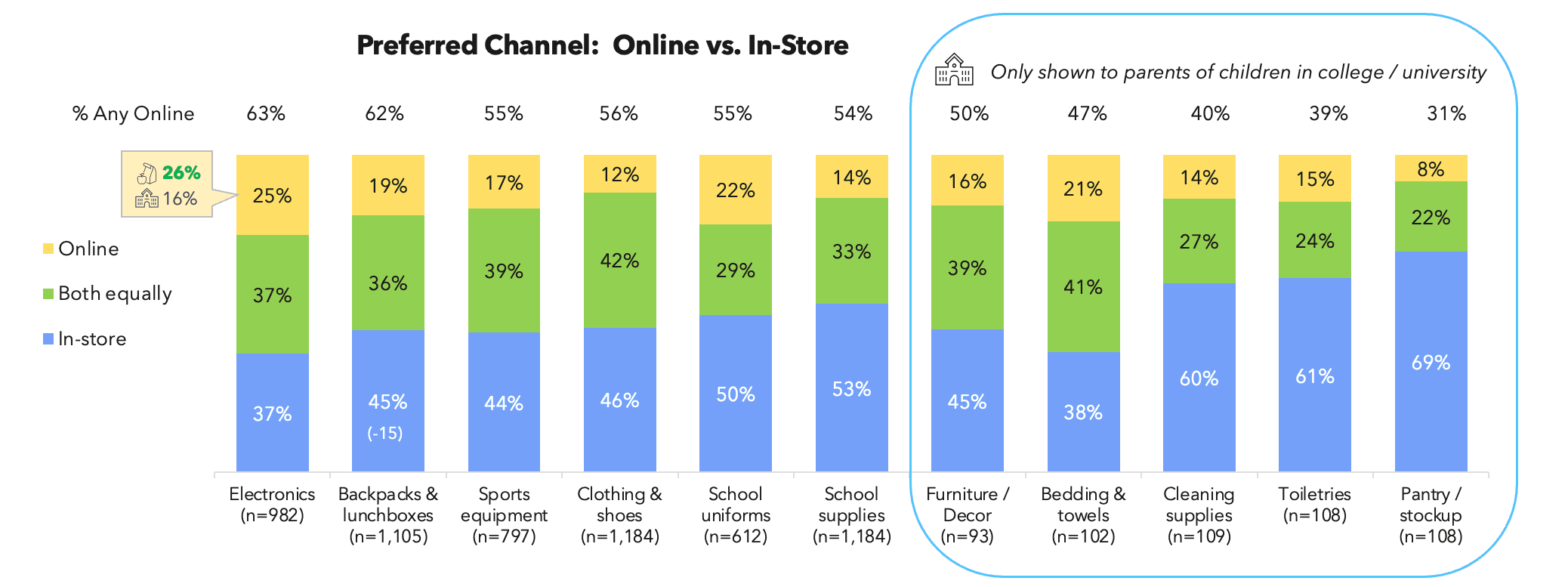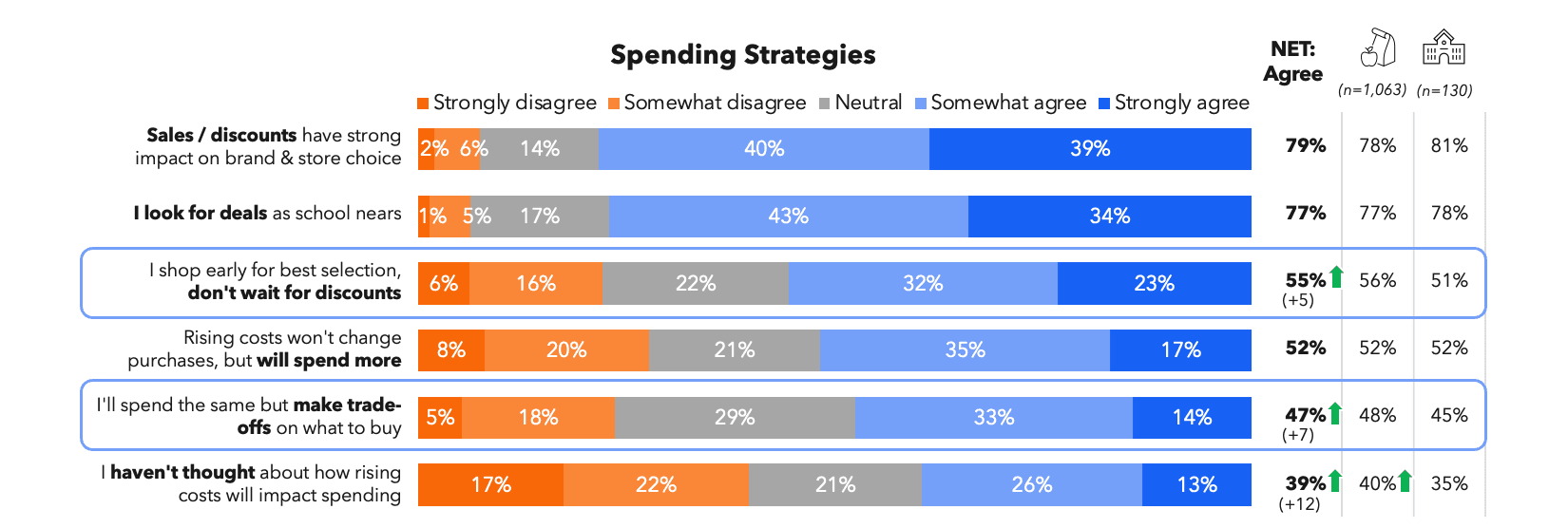


It might still be summer, but parents in the US have already started back-to-school shopping. Inflation and rising costs are still a concern for parents in 2025, but our research shows that tariffs are adding economic uncertainty as families start making their shopping lists.
This year, while parents are hoping to spend less on back-to-school shopping, 73% expect to go over budget due to tariffs and inflation.
To help marketers navigate the busy shopping season ahead, we surveyed parents of grade school and college/university children about when they’re starting to shop, how they’re approaching budgeting for the 2025/2026 school year, factors influencing their purchasing behavior, where they prefer to shop and more. Download the full report for yourself to dig a little deeper.
Aside from the impact of tariffs on the back-to-school shopping experience, we explored topics including which channels have the most influence on shopping decisions, which categories parents plan to prioritize this year, shifts in the types of retailers and brands parents choose for back-to-school supplies and more.
If you think the back-to-school shopping season comes earlier and earlier every year, you’re not wrong. Families are starting to shop for essentials way before August and September, with 43% adding ruler-lined notebooks, 2B pencils and school uniforms to their carts in early and late July.
This timing shift might be due to budgeting concerns, spending more time looking for discounts, or trying to spread expenses over a longer period of time.
“Retailers will need to take a truly individualized approach, with personalized offers and messaging complementing the overall shopping experience for parents—no matter if executed in-store, online or both. First-party data will be the key for retailers in unlocking the wallet share with this season’s rush to get kids ready for their first days at scale,” says Heather Campain, Epsilon’s Executive of Sales Strategy.
Marketing takeaway: Time deals and discounts with the primary window for shopping events. For back-to-school, make sure your best offers are live during late July and early August, and use this wisdom for the upcoming holiday shopping season, too, to make sure your marketing messages have the greatest opportunity to drive results.
When it comes to brand and retailer preferences, it comes down to balancing the best price with good value and product quality. And between managing kids’ busy schedules, maintaining homes and demanding jobs, parents are always looking for ways to save time and money, which often means shopping both in-store and online.
How parents choose to shop also depends on the item category. The top spending categories for 2025 include school supplies, clothing and shoes, backpacks and lunchboxes, electronics and cleaning supplies. Sports equipment and school uniforms are also top spending categories for parents of both grade school and college/university children.

Marketing takeaway: No matter the shopping event, it's key to prioritize the online experience, but make sure your in-store experience is up to par too so consumers are able to shop however and whenever makes sense for their busy schedules. It's also important to make sure that your website has clearly marked sections for events like back-to-school and holiday shopping so consumers can easily find and choose the items they're looking for.
It's no surprise that as more parents are on social media platforms, they're increasingly being influenced by them too. TikTok, Instagram and X saw the largest percentage increases of “extremely” and “very” influential responses since 2024, and more than 50% of respondents were influenced by all the social platforms we asked about, ranging from somewhat to extremely.
Grade school parents are more likely to be influenced by social media than college/university parents, which this is likely because they tend to be younger and are more socially savvy themselves.
Marketing takeaway: Diversify your marketing spend across social media channels to reach more consumers during major shopping events like back to school and holiday and ensure your campaign resonates across channels so messaging feels connected.
While our research has shown that brand loyalty overall has decreased, it still plays an important role in retailer preferences during the back-to-school shopping season. Twenty-five percent of parents surveyed say that loyalty programs influence which brands they choose.
Marketing takeaway: As marketers are planning their back-to-school messaging, they may consider including loyalty program details or earning potential, rewarding loyalty members with exclusive deals or offers (like earning 3x points on back-to-school supplies) or providing early access to back-to-school products in the app.
Unsurprisingly, sales and discounts have the strongest impact on the brands and stores parents choose. The most appealing offer types continue to be percentage discounts, followed by free shipping.
Compared to 2024, more parents anticipate spending the same amount but making tradeoffs on what to buy this year. There is a slight increase in those who say they will shop early for selection rather than waiting for discounts (relative to 2024).

Marketing takeaway: Make sure the offers you're sharing for key shopping events like back to school align with what consumers are really looking for and what they plan to spend the most money on (like electronics and clothing items). If consumers feel like they're able to cross more items off their list and get a better deal, they're more likely to choose a site that balances value and available selection.
For marketers to win during this back-to-school season, it's key to prioritize both in-store and online experiences. They also need to keep key shopping categories in mind for both grade school and college/university children, as the most popular categories and the categories with the highest spend differ depending on the child's age.
Promotional timing also matters: Since the bulk of back-to-school shopping takes place in late July and early August, ensure marketing campaigns and ad spend is aligned to those dates to make the biggest splash. When it comes to channels to prioritize, marketers should take an integrated approach to ensure campaign messages resonate across channels.
Want to learn more about what to expect for the 2025 back-to-school shopping season? Dive into the data and download a copy of the report today.